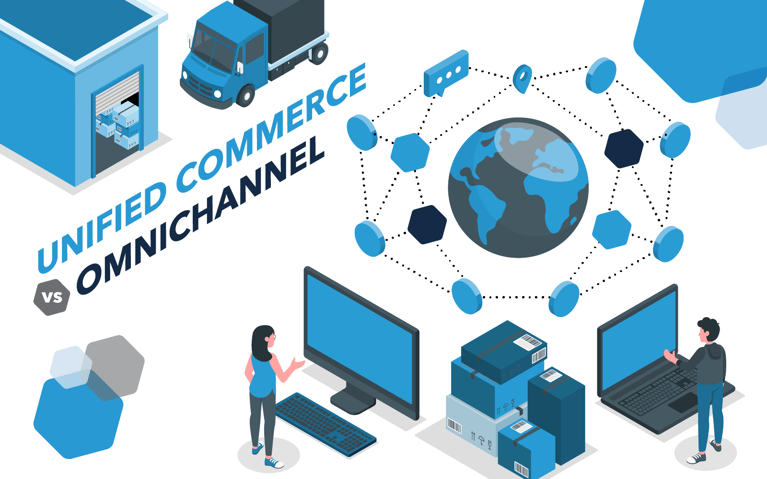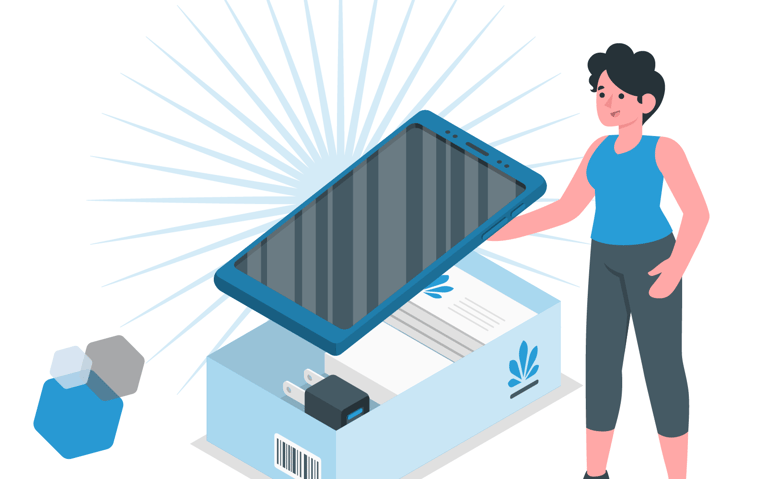Retailers can no longer operate in a single sales channel: It’s an omnichannel world and consumers are looking for convenience along with a consistent and cohesive brand experience. Although brick-and-mortar (the physical shopping experience) is still a valid option, it’s not a necessity for modern merchants. That said, today’s online consumers shop differently. They utilize storefronts, social platforms, online marketplaces and more. The key for ecommerce retailers is to digitally diversify how they sell to better meet the needs and expectations of their customers.
What is an ecommerce sales channel?
Ecommerce sales channels are the various platforms and channels through which businesses sell their products or services online. These channels can include a company's own website, third-party marketplaces like Amazon or eBay, social media platforms such as Facebook or Instagram, and even offline channels like brick-and-mortar stores with online sales capabilities.
Merchants that leverage multiple ecommerce sales channels reach a wider audience, diversify their revenue streams and can optimize their sales strategies to meet the preferences and behaviors of different customer segments. By effectively managing and integrating these channels, ecommerce retailers can enhance their online presence, drive sales growth and stay competitive in the digital marketplace while enhancing the customer experience.
What’s the difference between multichannel vs omnichannel selling?
Multichannel selling is offering products or services through multiple independent sales channels, such as a company website, social media platforms and third-party marketplaces, but these channels may operate in silos with little integration. On the other hand, omnichannel selling takes a holistic approach by seamlessly integrating all sales channels into a unified, cohesive experience for customers. In an omnichannel strategy, customers can transition between channels effortlessly, with consistent branding, pricing and customer service across all touchpoints. Omnichannel selling prioritizes customer convenience and engagement, aiming to provide a seamless journey from discovery to delivery, and beyond. Ultimately, while multichannel selling expands a company's reach, omnichannel selling enhances the overall customer experience, fostering loyalty and driving long-term growth and customer retention. When a brand can achieve unified commerce, they've given themselves a competitive edge.
What are the benefits of multiple ecommerce channels?
While handling multiple ecommerce sales channels may seem like extra work, today’s integrations make streamlining operations easier and provide better real-time visibility. The benefits far outweigh the effort to expand and create strategies around omnichannel selling. Retailers that use multiple ecommerce channels experience:
- Increased reach: Expanding sales across multiple channels allows businesses to reach a broader audience of potential customers.
- Diversified revenue streams: Leveraging multiple sales channels reduces dependency on any single platform or marketplace, spreading out risk and ensuring consistent revenue.
- Enhanced brand visibility: Presence on various channels increases brand exposure and recognition, reinforcing brand presence in the minds of consumers.
- Improved customer convenience: Multiple sales channels allow customers to shop where they prefer, increasing convenience and accessibility.
- Better customer insights: Businesses that manage multiple channels can gather data from various sources, which provides valuable insights into customer behavior and preferences.
When is the right time to expand into a new sales channel?
Entering a new sales channel takes planning and a strategic approach. First, you’ll want to look at the type of channel: Are you entering an online marketplace? Are you looking at working with a new retail partner? Are you planning to sell wholesale? Each channel requires a different strategy and considerations. Before expansion, consider:
- Audience demographics: Consider whether the target audience for the new sales channel aligns with your brand and product offerings.
- Competition analysis: Evaluate the competitive landscape on the new channel to understand market saturation, pricing dynamics and competitor strategies.
- Integration capabilities: Assess the feasibility of integrating the new sales channel with existing systems, such as inventory management, order fulfillment and customer support.
- Channel-specific requirements: Research any specific requirements or guidelines imposed by the new sales channel, such as listing fees, advertising options or content policies.
- Resource allocation: Determine the resources required to launch and maintain operations on the new sales channel, including staffing, technology investments and marketing expenses.
- Fulfillment needs: If your growth requires additional inventory and increased storage and/or warehouse locations, set your timeline to support a more successful launch. You’ll want to determine if and where the space is available, if your current fulfillment logistics provider can help you scale and if the costs are prohibitive or not. Additionally, the type of product will change your considerations – for example, apparel fulfillment, beauty fulfillment and footwear fulfillment will vary quite a bit from healthcare fulfillment.
What sales channels should you have?
You should have the sales channels that fit your product lines and brand. Beyond that, it’s a matter of timing. Common ecommerce sales channels include:
Online store (DTC)
An online store operating direct-to-consumer (DTC) sells products directly to customers through its own digital platform, bypassing traditional retail intermediaries. Customers browse the store's website, select products and make purchases online. Transactions are processed through the store's ecommerce platform. The store handles order fulfillment, shipping and customer service internally, maintaining direct control over the entire sales process.
Marketplaces
Online marketplaces are digital platforms serving multiple merchants. Ecommerce retailers can list and sell their products to a wide audience of consumers. Merchants must first create an account on the marketplace and then list their products, set prices and manage inventory within the platform's framework. Customers visit the marketplace, browse through various product listings from different sellers, make purchases and complete transactions directly on the platform. The marketplace typically facilitates payment processing, order fulfillment and customer support, providing a centralized and convenient shopping experience for both merchants and consumers.
Wholesale
Wholesaling is distributing your products to other businesses for resale rather than to consumers individually. It can act either as your primary sales channel or as part of a broader omnichannel strategy. It allows you to move large volumes of inventory in a single transaction.
B2B
A B2B sales channel is where you simply sell your products to other businesses. For example, you sell tires to an auto manufacturer, microfiber towels to cleaning businesses or stationery for corporate use. A B2B channel can be profitable since companies may have more spending power and have the potential to become a repeat buyer.
Mobile apps
Mobile apps act as a sales channel by providing a platform for brands to showcase and sell their products directly to customers through their smartphones or tablets. To create a mobile app as a sales channel, businesses typically follow these steps:
- Choose a development approach: Decide whether to build the app in-house, hire a development team or use app development platforms like Appy Pie or BuildFire.
- Design and development: Create wireframes and designs for the app's user interface, then proceed with development, ensuring it integrates seamlessly with your ecommerce platform or backend system.
- Include key features: Incorporate essential features such as product listings, shopping carts, secure payment gateways, user accounts, push notifications and customer support.
- Testing and optimization: Thoroughly test the app across different devices and operating systems to ensure functionality and usability. Gather feedback from beta testers and make necessary improvements.
- Launch and marketing: Publish on app stores like Google Play and Apple and promote it through social media, email marketing and search engine optimization (SEO).
- Monitor and iterate: Track app performance metrics, user engagement and sales data to identify areas for improvement and implement updates or new features to enhance the user experience and drive more sales.
How do you expand into a new sales channel?
Expanding into a new sales channel requires careful planning and execution to ensure success. Here are the steps you can follow:
- Conduct market research: Research potential sales channels to identify ones that align with your target market and brand objectives.
- Evaluate your options: Consider various sales channels such as online marketplaces, social media platforms, brick-and-mortar stores or wholesale partnerships, and evaluate their pros and cons.
- Set goals and objectives: Define specific goals for expanding into the new sales channel and the steps it will take to get there. Start thinking about a timeline and how long each objective will take. Goals might be increasing revenue, reaching a new audience or diversifying your distribution channels.
- Develop a strategy: Create a detailed plan outlining how you will enter the new sales channel, including budget allocation, marketing tactics, inventory management and logistics.
- Build or use your partnerships: If necessary, establish partnerships with distributors, retailers or online platforms to facilitate your entry into the new sales channel.
- Implement and optimize: Launch your products or services in the new sales channel and closely monitor performance metrics to identify areas for improvement.
- Iterate and scale: Continuously evaluate the success of your efforts by gathering feedback from customers and partners and adjust as needed to optimize your presence in the new sales channel. As you gain traction and confidence, consider scaling your operations to further capitalize on the opportunity.
How does an omnichannel fulfillment 3PL support ecommerce channel expansion?
An omnichannel fulfillment 3PL (third-party logistics provider) plays a critical role in supporting the expansion of ecommerce channels. One of the biggest barriers can be the ability to scale quickly. With the right 3PL, a scalable infrastructure is already in place. They have the framework and resources to handle increased order volumes across multiple sales channels without overwhelming internal operations. A 3PL also gives you flexibility and agility. They can help brands adapt quickly to changing market demands and seasonal fluctuations by scaling operations up or down as needed, without the constraints of fixed infrastructure costs.
A 3PL partner can also supply a diverse distribution network of strategically located fulfillment centers across different regions. This enables efficient order fulfillment and timely delivery to customers regardless of their location, supporting expansion into new markets. Additionally, many 3PLs offer advanced technology platforms that integrate with various ecommerce platforms and sales channels, providing real-time visibility into inventory levels, order status and shipping updates across all channels.
Expand into new ecommerce sales channels today
Let Cart.com help you expand into new sales channels. Our expert team can give you valuable insights and best practices for optimizing fulfillment operations, navigating regulatory requirements and maximizing efficiency in expanding ecommerce channels. We’re here to help brands make informed decisions and achieve sustainable growth. Contact our team today for more information.
Subscribe to our emails for the latest industry insights!
By entering your email, you agree to receive marketing emails from Cart.com





